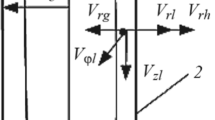Abstract
A mathematical model for separation of suspensions with a non-Newtonian disperse medium by dual-stage pressurized flotation in a cylindrical-conical hydrocyclone is developed. A system of differential equations of the convective diffusion and movement of a complex of particles-bubbles is solved by a numerical method. The concentration field is modeled, and integral separation indicators are determined. Values of structural parameters of the hydrocyclone for which the separation indicators depend heavily on the taper angle of the conical section of the housing and the rheological properties of the disperse medium are established.
It is demonstrated that dual-stage pressurized flotation makes it possible to reduce considerably the residual concentration of solid-phase particles as compared with single-stage flotation.
Similar content being viewed by others
References
V. O. Yablonskii and G. V. Ryabchuk, “Simulating the concentration field of SP in a hydrocyclone during separation of suspensions by pressurized flotation,” Zh. Prikl. Khim., 75, No. 10, 1687–1693 (2002).
B. V. Deryagin, S. S. Dukhin, and N. N. Rulev, Microflotation: Water Purification, Separation [in Russian], Khimiya, Moscow (1986).
V. O. Yablonskii, “Effect of the geometry of the working space of a cylindrical-conical hydrocyclone on the hydrodynamics of the flow of a non-Newtonian fluid,” Izv. Ross. Akad. Nauk. Mekh. Zhidk. Gaza, No. 2, 102–112 (2005).
D. Dyakowski, G. Hornung, and R. A. Williams, “Simulation of non-Newtonian flow in a hydrocyclone,” Chem. Eng. Res. Des. A., 72, No. 4, 513–520 (1994).
N. V. Tyabin, G. L. Dakhina, A. B. Golovanchikov, and A. A. Mamakov, “Design of ideal-displacement vessels for the separation of thin suspensions of electrolytic gases,” Teor. Osn. Khim. Tekhnol., 13, No. 6, 880–884 (1979).
N. V. Tyabin, A. B. Golovanchikov, G. L. Dakhina, and V. I. Zelentsov, “Optimization of electroflotation separation of suspensions,” Élektron. Obrab. Mat., No. 5, 65–67 (1986).
A. Acharya, R. A. Mashelkar, and J. Ulbrecht, “Flow of inelastic and viscoelastic fluids past a sphere,” Rheol. Acta., 15, No. 9, 454–463 (1976).
Y. Kawase and J. J. Ulbrecht, “Motion and mass transfer from an assemblage of solid spheres moving in a non-Newtonian fluid at high Reynolds numbers,” Chem. Eng. Commun., 8, No. 4–6, 213–231 (1981).
N. M. Matveev, Differential Equations [in Russian], Vysheishaya Shkola, Minsk (1976).
V. O. Yablonskii, “Analysis of the separation of suspensions with a non-Newtonian disperse medium in a straight-through cylindrical hydrocyclone,” Khim. Prom.., 82, No. 1, 40–48 (2005).
V. O. Yablonskii, “Effect of structural parameters of a cylindrical-conical hydrocyclone on separation indicators of suspensions with a non-Newtonian disperse medium,” Khim. Neft. Mashinostr., No. 9, 3–7 (2005).
Author information
Authors and Affiliations
Additional information
__________
Translated from Khimicheskoe i Neftegazovoe Mashinostroenie, No. 11, pp. 3–6, November, 2006.
Rights and permissions
About this article
Cite this article
Yablonskii, V.O. Selection of structural parameters of a cylindrical-conical hydrocyclone for separation of suspensions by dual-stage flotation. Chem Petrol Eng 42, 611–617 (2006). https://doi.org/10.1007/s10556-006-0151-9
Issue Date:
DOI: https://doi.org/10.1007/s10556-006-0151-9




